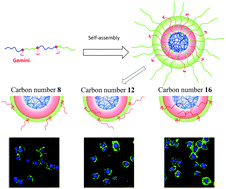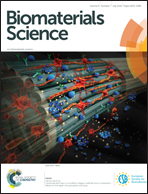Understanding the effect of alkyl chains of gemini cations on the physicochemical and cellular properties of polyurethane micelles†
Abstract
Cationic gemini quaternary ammonium (GQA) has been used as a cell internalization promoter to improve the permeability of the cell membrane and enhance the cellular uptake. However, the effect of the alkyl chain length on the cellular properties of nanocarriers has not been elucidated yet. In this study, we developed a series of polyurethane micelles containing GQAs with various alkyl chain lengths. The alteration of the gemini alkyl chain length was found to change the distribution of GQA surfactants in the micellar structure and affect the surface charge exposure, stability, and the protein absorption properties of nanocarriers. Moreover, we also clarified the role of the alkyl chain length in tumor cell internalization and macrophage uptake of polyurethane micelles. This work provides a new understanding on the effect of the GQA alkyl chain length on the physicochemical and biological properties of nanomedicines, and offers guidance on the rational design of effective drug delivery systems where the issue of functional group exposure at the micellar surface should be considered.



 Please wait while we load your content...
Please wait while we load your content...